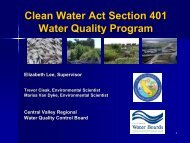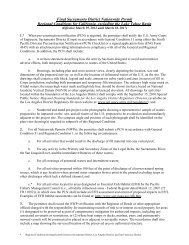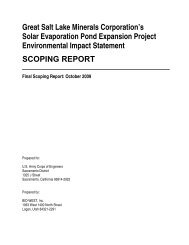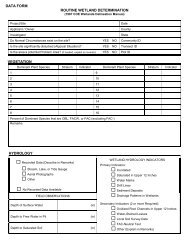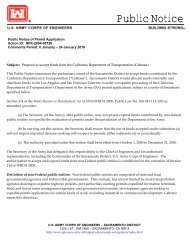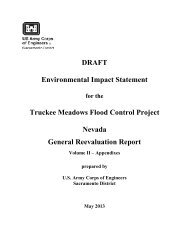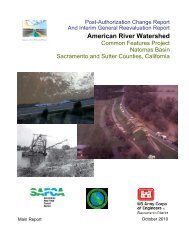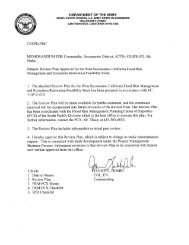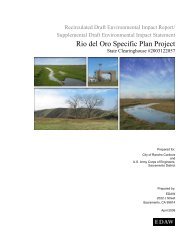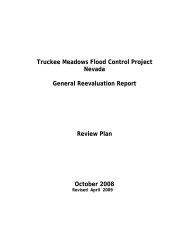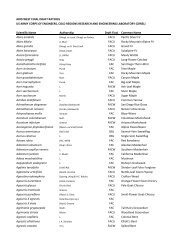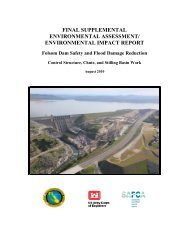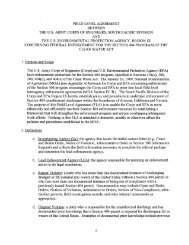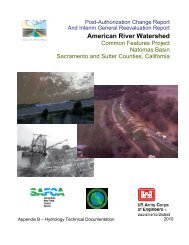4.0 CUMULATIVE IMPACTS - Sacramento District - U.S. Army
4.0 CUMULATIVE IMPACTS - Sacramento District - U.S. Army
4.0 CUMULATIVE IMPACTS - Sacramento District - U.S. Army
Create successful ePaper yourself
Turn your PDF publications into a flip-book with our unique Google optimized e-Paper software.
<strong>4.0</strong> Cumulative Impacts<br />
4.2.3 Definition of Study Area<br />
For each resource that was carried forth for cumulative impact assessment, the study area was defined<br />
based on the nature and characteristics of the resource.<br />
Study Area - Biological Resources<br />
Extensive areas of vernal pool habitat occur throughout California. Within the Central Valley, vernal pool<br />
habitat occurs in the transitional zone between the Sierra Nevada foothills and the valley flatlands.<br />
Although the Proposed Action is located in this transitional zone and therefore would contribute to the<br />
loss of vernal pool habitat in the entire Central Valley, to provide a more meaningful analysis of<br />
cumulative impacts, the study area for vernal pools and other biological resource impacts was defined to<br />
include a subregion of the Central Valley vernal pool belt. This subregion, shown in Figure <strong>4.0</strong>-1, Study<br />
Area for Cumulative Impacts, includes all of western Placer County, the northern portion of <strong>Sacramento</strong><br />
County, and the western portion of Sutter County.<br />
To delineate the boundaries of this study area, the USACE conducted a review of aerial photographs<br />
from 1970 of western Placer County and adjoining portions of Sutter and <strong>Sacramento</strong> counties, which is<br />
close to the time when the Clean Water Act was enacted. As vernal pools typically occur in landscapes<br />
that are shallowly sloping or nearly level at a broad scale, and typically occur embedded in grasslands, all<br />
areas that exhibited these characteristics on the aerial photographs from 1970 were assumed to support<br />
vernal pools and were included in the study area by the USACE. Lands that did not support grasslands<br />
or showed other landscapes such as agricultural fields or urban development were excluded. This<br />
approach was used to define the northern, western, and southern boundary of the study area. The eastern<br />
boundary of the study area was defined based on elevation above sea level. Based on the observed<br />
distribution of vernal pools, vernal pools primarily occur at elevations below 200 feet (61 meters).<br />
Therefore, a generalized eastern boundary was drawn corresponding roughly to the 200-foot (61-meter)<br />
contour. The study area defined in this manner encompasses the Western Placer County core area in the<br />
Vernal Pool Recovery Plan.<br />
The analysis of cumulative biological resource impacts is focused on this study area and documents the<br />
losses of vernal pool habitat that have occurred in this area since 1970 and additional losses that would<br />
result from the Proposed Action and other reasonably foreseeable future development through<br />
approximately 2060. As the study area is a subregion of the Central Valley vernal pool belt, past and<br />
present trends of habitat losses in the Central Valley are also briefly described below to provide the<br />
broader context for the cumulative impact.<br />
Study Area - All Other Resources<br />
The cumulative context for visual impacts is the area immediately surrounding the project site that has<br />
been previously developed or is proposed for development. Within this area, the study area is defined to<br />
include areas that are visible from major roadways, namely, Fiddyment Road and Baseline Road.<br />
The study area for cumulative impacts to farmland is defined to be the northern Central Valley,<br />
particularly southwestern Placer County, northern <strong>Sacramento</strong> County, and southeastern Sutter County,<br />
Impact Sciences, Inc. <strong>4.0</strong>-3 Sierra Vista Specific Plan Draft EIS<br />
USACE #200601050 July 2012



